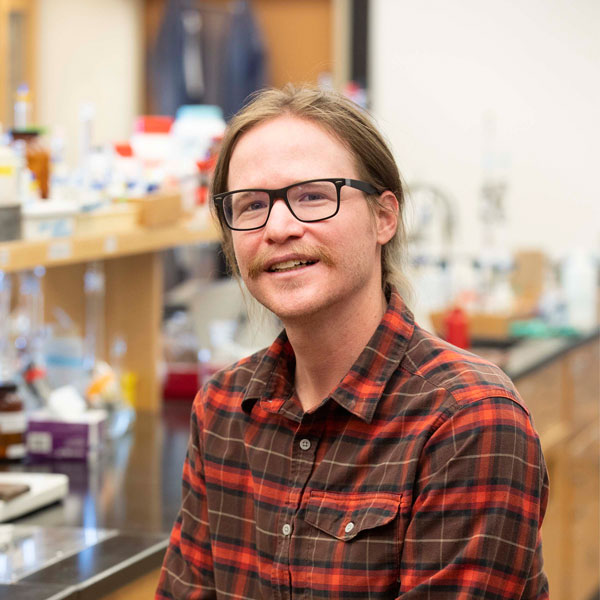Assistant Professor of Chemistry Eli Fahrenkrug has been awarded a $55,000 grant from the American Chemical Society's Petroleum Research Fund (ACS PRF) for a project, titled "Selective Polymorph Crystallization within the Electrical Double Layer." The grant, part of the ACS PRF's Undergraduate New Investigator program, will support three undergraduate research fellowships each summer for the next three summers; two fellowships will be supported by ACS PRF and one will be supported by Colorado College.
Of all drugs that are produced, more than 60% are orally delivered in a compressed pill or tablet format. More than half of these drugs exist in more than one crystalline structure. "This means that the molecules comprising the crystal (i.e. the pill) are unchanged, but the way they arrange themselves in space differs - this phenomenon is known as polymorphism. Simple changes in crystal structure can often render a therapeutic drug completely ineffective," Fahrenkrug says. "Controlling polymorphism is notoriously fickle and remains an outstanding challenge in the fields of chemistry and physics."
Fahrenkrug's project develops a new strategy for selective crystallization of polymorphs in massive electric fields. He explains that the electrons that hold atoms together through what are known as "bonds" are often unevenly distributed across the molecule. That means molecules can behave like tiny magnets and interact with external fields.
"We subject these molecules to electric fields on the order of those seen in lightning (one billion volts per meter) which induces alignment and leads to desired packing arrangements in crystals," says Fahrenkrug. "The major technical challenge here is that applying voltages over large distances leads to discharge and destruction of the molecules themselves - similar to how lightning strikes. To overcome this, we designed a new custom electrostatic reactor that allows for fields to be controllably applied at the nanometer scale - about a 10,000 times thinner than a hair - which avoids the problem."
There is considerable economic and scientific interest in polymorph prediction and control from the pharmaceutical industry to avoid dosage, processing, and patent problems, so it's critical that drug manufacturers have clear and deterministic mechanisms by which specific polymorph phases can be selectively produced. Because so many petrochemical resources are expended upon pharmaceutical drug development, this project is strongly rooted in the more general advancement of petroleum chemistry.
Additionally, Fahrenkrug recently published two articles, both in American Chemical Society publications, and was featured in an Office of Sustainability interview titled Incorporating Power and Equity into the Analytical Chemistry Curriculum.
The first of his articles, "In Situ Transmission Electron Microscopy Measurements of Ge Nanowire Synthesis with Liquid Metal Nanodroplets in Water," published in ACS Nano, is the result of a collaboration between Fahrenkrug and researchers at University of Michigan. He explains that semiconductor materials form the basis of all modern energy materials including solar cells, electronics, and batteries - but they are enormously energy intensive to produce which incurs additional expense to the downstream consumer.
"Several years ago, we pioneered a new disruptive technology that can produce these materials directly in water at room temperature using a technique called 'electrochemical liquid liquid solid growth'. The key innovation was the use of a liquid metal electrode that served as a solvent for these materials to crystallize from." Fahrenkrug compares it to making rock candy, saying it's a similar process. "We used electrochemistry to dissolve atoms into the liquid metal - after a period of time, the atoms coalesced into a crystal and emerged from the surface of the liquid metal like rock candy."
The article captures several years of work studying the detailed mechanism of this new crystal growth process, Fahrenkrug says. "We used a transmission electron microscope (TEM) to watch crystals grow in real time at the atomic level. The work provides detailed insight into the mechanism, which can later be exploited for better control of the process."
The second article, "The Flint, Michigan Water Crisis as a Case Study to Introduce Concepts of Equity and Power into an Analytical Chemistry Curriculum," published in the Journal of Chemical Education, is the result of several years of collaboration between Fahrenkrug and Paul Buckley, former director of Colorado College's Butler Center. Fahrenkrug says they developed a new pedagogical framework for teaching technical analytical chemistry content through the lens of power, equity, racism, and environmental justice. The complex nature of the Flint, Michigan, water crisis provided the opportunity to develop a modular case study that engaged both the underlying aspects of power inequity that led to the crisis, as well as the key chemical concepts, laboratory analysis techniques, chemical modeling, and scientific translation. Fahrenkrug says the six complementary modules of the case study included:
- A guided discussion of water, power, and privilege in Flint
- An in-class guided inquiry exercise introducing chemical concepts key to the water crisis
- A hypothesis-driven laboratory analysis of real Flint waters
- A statistical data validation exercise
- An introduction to software-based chemical equilibrium modeling
- Multiple modes of scientific translation to nonscientists.
Students were asked to understand the history and politics of the problem, the complex chemistry at its center, and ultimately, the challenges in communicating such complexity back to the stake holders who were at greatest risk.
Coincidentally, the Colorado College Common Read this year was "What the Eyes Don't See" by Mona Hanna-Attisha, the story of how Hanna-Attisha, alongside a team of researchers, parents, friends, and community leaders, discovered that the children of Flint, Michigan, were being exposed to lead in their tap water. Hanna-Attisha also was CC's First Mondays speaker on Sept. 21.



